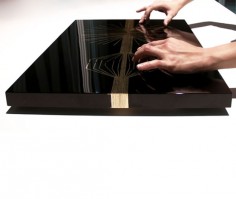MATT ROGERS AND YURI SUZUKI
Urushi

source: 3dnewsru
Японский дизайнер и музыкант-электронщик Юри Сузуки (Yuri Suzuki) принял участие в выставке «Collacqueration: designed in the UK – lacquered in Japan», где представил интерактивную музыкальную систему Urushi. Мероприятие посвящено совместной работе молодых британских дизайнеров и хранителей традиций японского искусства.
Urushi
Интерактивная система Urushi представляет собой электронный музыкальный инструмент, только играть приходится не на традиционной фортепьянной раскладке с черными и белыми клавишами, а на виртуальных струнах, которые отображаются на сенсорном дисплее. А дисплей, конечно же, поддерживает мультисенсорное управление, что позволяет играть на инструменте не только одиночными нотами, но и аккордами. Кроме того, Urushi можно использовать и как MIDI-контроллер, который подключается к любому другому совместимому музыкальному инструменту.
.
.
.
.
.
.
.
source: yurisuzuki
Urushi Musical Interface
in collaboration with Takashi Wakamiya and Matt Rogers
Wajima in ishikawa prefecture, lies at the tip of the noto peninsula which juts into the sea
of japan, and the lacquer of Wajima is an important intangible cultural property of japan.
It is made using original techniques consisting of at least 20 and sometimes more
than 100 processes, giving it extra durability. wajima lacquer is also known for its
highly decorative features, such as makie, whereby metal or colored powder is sprinkled
on the lacquer, and chinkin, which involves scoring a pattern of lines on the lacquer
and then rubbing gold powder into these areas. urushi is a natural material prepared
from the toxic sap of the lacquer tree extant throughout east asia. it is one of the most
durable natural adhesives and varnishes known. Penetrating and sealing porous
surfaces, its application is used to increase the utility of materials such as wood,
bamboo, textiles and paper as well as coating the interiors of temples and shrines.
The decorative appeal of lacquer is also greatly admired with both opaque or highly
polished, lustrous finishes. as a result of numerous separate applications of lacquer,
the surface veneer can be thick enough to allow it to be incised or carved.
Black lacquered surface of the instrument is contrasted by the gold inlay lines of the actual
interface using the chinkin technique ‘when I got involved in this collaboration with the wajima
lacquer craftsman, I was amazed at how fine and beautiful a pattern one can produce on the
surface of glossy black lacquer pain through the gold inlay technique. then I became interested
in making an electronic musical interface which uses this technique. I also decided the
project
should be fulfilled both something as a beauty of aesthetic and of functionality.
the gold inlay is a
conductive surface, so when one touches it, the instrument will be switched on.
.
.
.
.
.
.
.
source: restaurarcasa
Con este nombre se conoce un tipo de lacado realizado por artesanos japoneses de tradición milenaria. En la actualidad también recibe este nombre el conjunto de técnicas y los objetos producidos por ella. Esta técnica de lacado se aplica tanto a mobiliario como a objetos decorativos o de uso cotidiano.
A partir del urisol (una resina que se extrae del árbol Rhus Vernicifera) y siguiendo las técnicas tradicionales, los artesanos consiguen la laca natural más apreciada, tanto por su durabilidad como por su belleza.
Su impermeabilidad y adherencia son altísimas lo que hacen posible que el objeto al que se aplica se conserve mucho tiempo, incluso se han hallado restos arqueológicos de más de tres mil años en perfecto estado.
Se aplica tanto a mobiliario como a objetos decorativos o de uso cotidiano.
Estéticamente es muy atractiva por su brillo y suavidad y aunque su color natural es el marrón, pueden utilizarse multitud de pigmentos para conseguir una gama muy amplia de tonalidades. El resultado de la aplicación de este tipo de lacado es monocromo o, si se sigue la técnica conocida como Negoro, de dos colores.
También se pueden realizar incrustaciones o aplicar dibujos decorativos sobre la laca urushi.
El soporte principal del urushi es la madera pero se puede utilizar en muchos otros materiales como bambú, cuero, telas, cartón y muchos otros.

